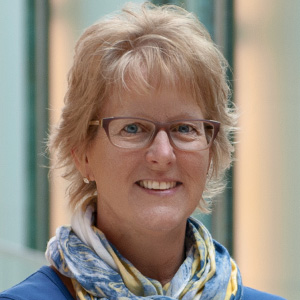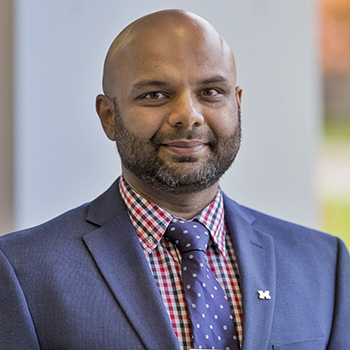Many Hands: From Idea to Product, a Commercialization Journey
Monday, January 15, 2024
Healthcare
A patient using the Grip Forté rehabilitation device at a clinic in India.
the Grip Forté hand and wrist rehabilitation device is a lesson in partnership. WDI connected U-M students, faculty and healthcare providers
The Grip Forté is a reasonably simple device to use. Created using a 3D-printer, the 8 inch square collapsible cube is powered by springs and the patient’s strength. It was developed to help patients to rehabilitate hand and wrist strength, flexibility, and control.
And while the Grip Forté itself isn’t complicated, the road from concept to construction wound through a series of partnerships – between teams around the globe, various departments at the University of Michigan, and engineers and healthcare professionals. Every step required a cooperative approach to problem-solving, medical support, and economic strategy. These are familiar commercial crossroads for the William Davidson Institute at the University of Michigan (WDI).
Developing a new medical product is a complex process and developing one for use in low- and middle-income countries (LMICs) is even more complicated. In these settings, creators must grapple with challenging supply chain resources, few investors, and limited knowledge of how best to commercialize a new product. Doing so demands a strong collective effort, and WDI relied on its deep well of partners to move this product forward. As its development progressed, the potential impact of Grip Forté became clear.
Finding a market, filling a need
The Grip Forté journey began with a course through the Global Health Design Initiative at the University of Michigan. Led by Kathleen Sienko, professor of mechanical engineering, and Julia Kramer, assistant professor of mechanical engineering, the immersive experience trains student engineers to work with stakeholders to identify up to 100 unmet medical needs with potential engineering solutions.
After narrowing down the possibilities, the student engineers landed on just such a pairing: A mobile, small-scale device for patients needing to build strength and control following a hand or wrist injury. The WDI team decided to field test the device with both Dr. Abena Tannor, a Ghanaian clinician who recently completed specialist training in physical medicine and rehabilitation, and Dr. B. Shibu, Chief Medical Officer & Consultant Physiatrist at Poovanthi Rehabilitation Institute in India. WDI first began working with Poovanthi’s founders in 2010 when the organization was still in the planning stages and has continued the partnership since the organization was founded in 2011.
Learn more about Tannor’s story here.
Once they gained a good understanding of the specific therapy requirements, the students designed a device to fit the need. The initial prototype showed promise but was set aside when the course came to completion and the students moved on. It was at this point in the project that Professor Sienko approached WDI to see about the business possibilities for the product. WDI has worked with hundreds of organizations on business plans and models over the years and it began to take a lead role in investigating the commercial prospects for this device.
“At WDI, we understand and appreciate the power of collaboration in moving our mission forward and making things happen when it comes to launching new businesses and products,” said Claire Hogikyan, WDI Vice President of Administration, who has led the commercialization efforts. “As an independent nonprofit we have the ability and privilege to seamlessly reach out to other institutes and departments at the University to find projects that support their goals — while expanding economic and social freedom in LMICs. Grip Forté is one of those projects.”

At WDI, we understand and appreciate the power of collaboration in moving our mission forward and making things happen when it comes to launching new businesses and products.
Claire Hogikyan, vice president of administration for the William Davidson Institute
WDI tasked two U-M Ross graduate students to determine the device’s potential business path forward, including possible price points, the likelihood of local manufacturing, and an assessment of the market. They determined there was a space for the product to thrive and, as importantly, a space for it to serve.
The students from the Global Health Design Initiative course had identified the need — a population in Ghana that required physical therapy but was underserved. Their prototype had potential, but there were challenges to overcome in the Ghanaian market. It was made of wood, which is heavy. It also relied on rubber bands for resistance training. However, the rubber bands necessary for that function are nearly impossible to find in Ghana. Considering the need, the commercial prospects, and the design issues, the WDI team set about to transform the initial prototype into a more viable product for the region.
Leaning on Critical Connections
Building out a functional product wasn’t something WDI could do alone, so the Institute turned to its vast network of connections to bring the concept into existence. The first step was with Anthony M. Waas, a professor in the Aerospace Engineering department of the College of Engineering. He laid out a starting point for the team: 3D printing. It was the perfect solution to the production and supply chain challenges in most LMICs.
Tannor agreed with the assessment and was glad to lean into the technology. “Traditional rehabilitation methods and devices can be expensive and inaccessible. Grip Forté’s 3D printing technology provides a more cost-effective and easily accessible solution,” Tannor said via email.
WDI went on to enlist the work of Avin Vijay, an assistant research scientist also in the aerospace department. Vijay works closely with the mechanics of structures, 3D printing and design optimization. Vijay and his students created a prototype that could be completely manufactured in Ghana and around the globe. They built the Grip Forté using common thermoplastic polyester, with 3D-printed springs to replace the rubber bands and metric bolts that are small, sturdy and readily available.
On the production side, Colin Hunter, a student in the Penny W. Stamps School of Art & Design who collaborates with the Department of Aerospace Engineering helped WDI select the best 3D printer for the job — one that would effectively and efficiently print the product and be readily available for a reasonable price in locations outside the U.S.
Once they began the printing process, the next step was to test the product. WDI leaned on its connections at Saint Joseph Mercy Health System to find local physical therapists to conduct some initial experiments. The staff determined the product had potential uses in LMICs, where patients need convenient access to these low-cost therapies. The WDI team decided to field test the device with both Dr. Tannor in Ghana and Dr. B. Shibu, Chief Medical Officer & Consultant Physiatrist at Poovanthi Rehabilitation Institute in India.
This widespread evaluation and analysis was essential to developing the most effective design, explained Vijay. “WDI gave us critical global contacts for this project,” he said. “We now have a global market for the product and are receiving feedback from patients within those markets.”

WDI gave us critical global contacts for this project. We now have a global market for the product and are receiving feedback from patients within those markets.
Avin Vijay, aerospace assistant research scientist at the University of Michigan
This widespread evaluation and analysis was essential to developing the most effective design, explained Vijay. “WDI gave us critical global contacts for this project,” he said. “We now have a global market for the product and are receiving feedback from patients within those markets.”
Tannor and Shibu tested the products with patients in their centers and received mostly positive reviews. There was one issue: Patients were using the device for an additional exercise that it wasn’t built to support, breaking two of the springs. Vijay had a new task ahead of him: redesigning those springs to manage that new movement.
“WDI is co-located and affiliated with a major research university. We know there are other ideas out there languishing on shelves that could become commercialized products in LMICs. If there are other people with an idea, with a prototype, but who don’t know what to do next, WDI might be the place to go to,” said Hogikyan. “We have the skill and importantly, the connections to move ideas forward.”
Taking It a Step Further
As the Grip Forté continues to undergo field testing, it also continues to evolve. While Vijay and his students are tackling the issue of adjusting the springs, they’re also working on an avenue to turn its creation into a circular economy.
The team is developing ways to recycle plastic bottles into the filament needed to print the device. Using opensource code, the group is using the 3D printer to print a machine that will function as a recycling tool. This will add even more value to the local economy while also reducing the cost of 3D printing. Plastic bottle collectors could earn money by selling the material to device builders, enabling device builders to broaden their business by printing additional items.
“If we can put together a model where the endgame is both helping to improve the health and wellbeing of individuals while also repurposing plastic waste, that is a nice win,” Hogikyan said.
The Grip Forté is the most recent WDI commercialization project, but it’s far from the only one underway. WDI and the Technological Institute of the Philippines recently began a six-month effort to commercialize technologies produced through funded research and special projects. At the same time, WDI is supporting the second annual Global Health Commercialization Competition. Co-sponsored by Fast Forward Medical Innovation (FFMI), the Center for Global Health Equity, and WDI, the competition will create and support a community of U-M faculty innovators actively working on technical solutions to healthcare problems in emerging markets. The program will include two key components: A professional development course and a pitch competition where the winning team will receive $30,000 to advance their concept to the marketplace.
